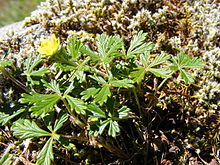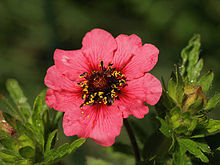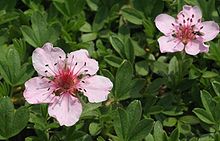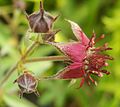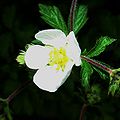- Potentilla
-
- "Cinquefoil" redirects here. For other uses, see Cinquefoil (disambiguation).
Potentilla 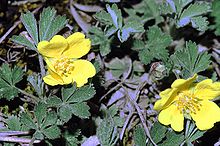
Potentilla arenaria Scientific classification Kingdom: Plantae (unranked): Angiosperms (unranked): Eudicots (unranked): Rosids Order: Rosales Family: Rosaceae Subfamily: Rosoideae Genus: Potentilla
L.Species About 500, see text and Species of Potentilla
Synonyms Duchesnea
and see text and Species of PotentillaPotentilla (
 /ˌpoʊtənˈtɪlə/)[1] is the genus of typical cinquefoils, containing about 500 species of annual, biennial and perennial herbs in the rose family Rosaceae. They are generally Holarctic in distribution, though some may even be found in montane biomes of the New Guinea Highlands. Several other "cinquefoils" formerly included here are now separated in distinct genera.
/ˌpoʊtənˈtɪlə/)[1] is the genus of typical cinquefoils, containing about 500 species of annual, biennial and perennial herbs in the rose family Rosaceae. They are generally Holarctic in distribution, though some may even be found in montane biomes of the New Guinea Highlands. Several other "cinquefoils" formerly included here are now separated in distinct genera.Some species are called tormentils, though this often is used as a shorthand for Common Tormentil (P. erecta). Others are referred to as "barren strawberries", which may also refer to P. sterilis in particular, or to the closely related but not congeneric Waldsteinia fragarioides.
Contents
Nomenclature
"Cinquefoil" in the Middle English Dictionary by Sherman M. Kuhn, is described as "Pentafilon – From Greek Pentaphyllon – influenced by foil, a leaf. The European cinquefoil (Potentilla reptans), often used medicinally." The word is derived from Old French cinc, Middle English cink and ultimately Latin quinque – all meaning "five" –, and feuille and foil/foille which mean "leaf". Formerly this term referred to five-leaved plants in general. In Medieval times, the word "cinquefoil" was used almost exclusively in England. In France, the genus was called quintefeuille, first attested in Normandy and Brittany in the 11th century.
The scientific name seems to have been influenced by a fusion of ancient names for these plants: Common Tormentil (P. erecta) was known as tormentilla in Medieval Latin, derived from early Spanish – literally "a little torment", meaning pain that while not debilitating is unpleasant and persistent (such as a belly ache, against which P. erecta was used). The change from initial "t" to "p" seems to have been influenced by terms such as poterium – Latin for the related burnets (Sanguisorba) –, or propedila and similar words used for the Creeping Cinquefoil (P. reptans) in the now-extinct Dacian language, as attested in Latin herbals.
In A Dictionarie of the French and English Tongues, compiled by Randle Cotgrave in 1611, the French word potentille is defined as a "wild Tansie, a silver weed" – i.e. any of several composite plants of the genus Tanacetum especially T. vulgare. The related adjective potentiel/potentiells means "strong", "forcible" or "powerful in operation". Its origin is the French potence ("strong", "powerful", "mighty" or "potent"). The origin of these words is the Latin potens, with the same meaning.
Description and ecology
Typical cinquefoils look most similar to the strawberries, but differ in usually having dry, inedible fruit (hence the name "barren strawberry" for some species). Many cinquefoil species have leaves divided into five leaflets arranged palmately like the fingers of a hand. Because of such shape of leaves, some species are called five-finger. Some species, such as the Barren Strawberry, have just three leaflets, and others (e.g. P. anserina) up to 15 or more leaflets arranged pinnately. The flowers are usually yellow, but may be white, pinkish or even red; the accessory fruit are usually dry but may be fleshy and strawberry-like, while the actual seeds – each one technically a single fruit – are tiny nuts. Cinquefoils grow wild in most cool and cold regions of the world. Most species are herbs but a few are erect or creeping shrubs. Some Cinquefoils are troublesome weeds. Other types are grown in gardens.
Potentilla diversifolia at 1,636 metres (5,367 ft) in Olympic National Park
Cinquefouls are a prominent part of many ecosystems. In the United Kingdom alone, Common Tormentil (P. erecta) together with Purple Moor Grass (Molinia caerulea) defines many grassy mires, and grows abundantly in the typical deciduous forest rich in Downy Birch (Betula pubescens) Common Wood-sorrel (Oxalis acetosella) and Sessile Oak (Quercus petraea). In upland pastures on calcareous soil it typically accompanies Common Bent (Agrostis capillaris), Sheep's Fescue (Festuca ovina) and Mother-of-Thyme (Thymus praecox). The boggy heathlands of southern Britain dominated by Bristle Bent (A. curtisii) and Western Gorse (Ulex gallii) as well as those on The Lizard peninsula, characterized by Cornish Heath (Erica vagans) and Black Bog-rush (Schoenus nigricans), are also usually inhabited by the Common Tormentil. But it is most commonly seen in regions dominated by Common Heather (Calluna vulgaris) – be it the common lowland heaths rich in Bell Heather (Erica cinerea), maritime heath where Spring Squill (Scilla verna) grows in abundance, the submontane heaths of the north dominated by the peat moss Sphagnum capillifolium and Bilberry (Vaccinium myrtillus), or montane heathlands of Scotland with plentiful Alpine Juniper (Juniperus communis ssp. alpina).
Spring Cinquefoil (P. neumanniana) on the other hand is rare in Britain, found generally only in some southern calcareous grasslands rich in Sheep's Fescue; in the southwest it associates with Carline Thistle (Carlina vulgaris), whereas in the southeast it is usually accompanied by Mouse-ear Hawkweed (Hieracium pilosella) and either or both Mother-of-Thyme and Large Thyme (T. pulegioides).
The leaves of some cinquefoils are eaten by the caterpillars of some Lepidoptera (butterflies and moths), in particular grizzled skippers (Pyrgus) of the Hesperiidae; see list of Lepidoptera that feed on Potentilla. The plants' flowers are also occasionally visited by adult Lepidoptera; the endangered Karner Blue (Lycaeides melissa samuelis) for example includes nectar of Common Cinquefoil (P. simplex) among its common food sources. Polish Cochineal (Porphyrophora polonica), in former times commercially important in crimson dye production, is a notable parasite of cinquefoils on sandy soils of Eastern Europe and western Asia.
The flowers of cinquefoils are pollinated by such insects as the Fernald cuckoo bumble bee, Bombus fernaldae.[2]
Use by humans
Some of the typical cinquefoils are grown as ornamental plants. These are generally high species with bright, showy flowers, such as P. atrosanguinea, P. nepalensis and Sulphur Cinquefoil (P. recta). Horticultural hybrids such as Hopwood's Cinquefoil (P. × hopwoodiana) and Tongue Cinquefoil (P. × tonguei) have also been bred, and there exists a range of cultivars. Even double-flowered cinquefoils have been bred, starting with Victor Lemoine's 1854 'Gloire de Nancy'. Other species are useful for more specialized gardening purposes, such as rock gardens or swamps. Among the former is the hardy Spring Cinquefoil (P. neumanniana), the floral emblem of Cromartyshire.
Some species are used in herbalism. P. fragarioides contains D-Catechin and is used as a hemostatic in Traditional Chinese Medicine, while Common Tormentil (P. erecta) was similarly used in European folk medicine, and also to treat diarrhea and other gastrointestinal ailments. It is rich in flavonoids, saponins, tannins, as well as phenol and the glycoside tormentilline, and has been shown to be bacteriostatic and virostatic. It also contains the red dye tormentole and was sometimes used to colour leather and other materials in former times.
Common Tormentil has also been used in transplant research, demonstrating that these are useful to distinguish between subspecies, and forms and varieties: the former are distinct populations with strongly heritable traits, while the latter two have distinguishing traits produced by ecological conditions and often not inheritable.
In art
- See also Charge (heraldry)#Plants
In heraldry, the cinquefoil emblem or "potentilla" signified strength, power, honor and loyalty. Depiction of the five-petaled flower appears as early as 1033, in the architecture of the church built in the village of Reulle-Vergy (Burgundy, France), two years before the reign of William the Conqueror. The cinquefoil emblem was used generously in the architecture of numerous churches built in Normandy and Brittany, through the 15th century.
From the 11th to 14th century, the word potence – related to Potentilla, as per above – was used mainly in a military context and to describe the condition of the soul. During the time of William the Conqueror, the potentilla was used as an emblem on the coat of arms of Bardolph of Bretagne, who in 1066 was the master of the William's military engineer corps.
Systematics and taxonomy
 Creeping Cinquefoil (P. reptans), the type species of Potentilla, was scientifically described by Linnaeus in 1753.
Creeping Cinquefoil (P. reptans), the type species of Potentilla, was scientifically described by Linnaeus in 1753.
Analysis of internal transcribed spacer DNA sequence data has yielded valuable information on cinquefoil relationships, supporting previous hypotheses about their relationships but also resulting in a number of changes to the circumscription of Potentilla:[3]
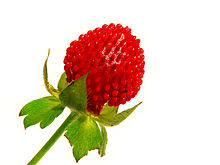 Fruit of Mock Strawberry (Potentilla indica), formerly in Duchesnea but in fact a close relative of Creeping Cinquefoil[3]
Fruit of Mock Strawberry (Potentilla indica), formerly in Duchesnea but in fact a close relative of Creeping Cinquefoil[3]
Among the Rosidae, the typical cinquefoils are close relatives of such plants as the avens of genus Geum and the roses (Rosa), and even closer relatives of the agrimonies (Agrimonia). Yet more closely related to Potentilla are the lady's mantles (Alchemilla) and strawberries (Fragaria). The avens of genus Dryas are not as closely related as long believed though.
The genera Duchesnea (Mock Strawberry), Horkelia (horkelias), and Ivesia (mousetails), previously all regarded as distinct, are often but not universally included in Potentilla today. Conversely, the shrubby plants previously included in this genus are well distinct and now separated in the genus Dasiphora, while some distinctive and apparently protocarnivorous[4] herbaceous cinquefoils are placed in Drymocallis. Marsh Cinquefoil and the disputed Potentilla salesowianum are now separated into the genus Comarum, and the Three-toothed Cinquefoil is transferred to the monotypic genus Sibbaldiopsis. As already proposed by John Hill in the 18th century, the silverweeds are probably also separable as genus Argentina, though as it seems they are the immediate sister genus of Potentilla: as the boundary between them remains to be defined in detail, it is not inconceivable that the silverweeds will in the future again be included with the typical cinquefoils in a single genus.
Selected species
- Potentilla alba – White Cinquefoil
- Potentilla adenotricha
- Potentilla alchemilloides – Alchemilla-leaved Cinquefoil
- Potentilla anadyrensis
- Potentilla angelliae
- Potentilla anglica Laichard. – Trailing Tormentil
- Potentilla arenaria Borkh.
- Potentilla argentea L. – Hoary Cinquefoil
- Potentilla atrosanguinea Lodd., G.Lodd. & W.Lodd.
- Potentilla aurea L.
- Potentilla beringensis Jurtzev
- Potentilla biennis Greene – Biennial Cinquefoil
- Potentilla biflora Willd. ex Schltdl. – Twoflower Cinquefoil
- Potentilla bifurca
- Potentilla bipinnatifida – Tansy Cinquefoil
- Potentilla canadensis L. – Canadian Cinquefoil, Dwarf Cinquefoil
- Potentilla canadensis var. canadensis
- Potentilla canadensis var. villosissima
- Potentilla caulescens L.
- Potentilla chamissonis – Bluff Cinquefoil
- Potentilla cinerea – Grey Cinquefoil
- Potentilla clusiana Jacq.
- Potentilla collina Wibel
- Potentilla concinna – Red Cinquefoil
- Potentilla cottamii
- Potentilla crantzii – Alpine Cinquefoil
- Potentilla cristae – Crested Cinquefoil
- Potentilla delphinensis Gren. & Godron
- Potentilla diversifolia Lehm. – Mountain Meadow Cinquefoil, Varileaf Cinquefoil, Different-leaved Cinquefoil
- Potentilla drummondii – Drummond's Cinquefoil
- Potentilla effusa – Branched Cinquefoil, Spreading Cinquefoil
- Potentilla elegans – Elegant Cinquefoil
- Potentilla erecta – Common Tormentil
- Potentilla eversmanniana Fisch. ex Ledeb.
- Potentilla fissa – Bigflower Cinquefoil
- Potentilla flabellifolia Hook. ex Torr. & A.Gray – Fanleaf Cinquefoil, High Mountain Cinquefoil, Fan-foil
- Potentilla fragarioides
- Potentilla fragiformis Willd. ex Schltdl. – Strawberry Cinquefoil
- Potentilla geranioides
- Potentilla glandulosa – Sticky Cinquefoil, Gland Cinquefoil
- Potentilla goldbachii
- Potentilla gracilis – Slender Cinquefoil, Combleaf Cinquefoil
- Potentilla grandiflora
- Potentilla grayi S. Watson – Gray's Cinquefoil
- Potentilla heptaphylla L.
- Potentilla hickmanii – Hickman's Cinquefoil
- Potentilla hippiana Lehm. – Horse Cinquefoil, Woolly Cinquefoil
- Potentilla hookeriana Lehm. – Hooker's Cinquefoil
- Potentilla × hopwoodiana Sweet – Hopwood's Cinquefoil
- Potentilla × hybrida – Hybrid Cinquefoil (P. crantzi × P. neumanniana)
- Potentilla inclinata Vill. – Ashy Cinquefoil, "grey cinquefoil" (= P. canescens)
- Potentilla indica – Mock Strawberry
- Potentilla insularis
- Potentilla intermedia – Russian Cinquefoil
- Potentilla johnstonii
- Potentilla macedonica – Macedonian Cinquefoil[5]
- Potentilla macounii – Macoun's Cinquefoil
- Potentilla matsumurae
- Potentilla micrantha – Pink Barren Strawberry
- Potentilla millefolia Rrdb. – Cutleaf Cinquefoil
- Potentilla montenegrina Pant.
- Potentilla morefieldii Ertter – Morefield's Cinquefoil
- Potentilla multifida L. – Divided Cinquefoil
- Potentilla nana Willd. ex Schltdl. – Arctic Cinquefoil (= P. hyparctica)
- Potentilla nepalensis Hook.
- Potentilla neumanniana – Spring Cinquefoil, Spotted Cinquefoil
- Potentilla newberryi A.Gray – Newberry's Cinquefoil
- Potentilla nitida L.
- Potentilla nivea L. – Snow Cinquefoil
- Potentilla nivea ssp. nivea
- Potentilla nivea ssp. subquinata
- Potentilla norvegica L. – Norwegian Cinquefoil, Rough Cinquefoil, Ternate-leaved Cinquefoil
- Potentilla norvegica ssp. monspeliensis
- Potentilla norvegica ssp. norvegica
- Potentilla ovina – Sheep Cinquefoil
- Potentilla pamirica
- Potentilla paradoxa Nutt. – Bushy Cinquefoil
- Potentilla pensylvanica L. – Pennsylvania Cinquefoil
- Potentilla plattensis – Platte River Cinquefoil
- Potentilla pletvarensis – Pletvar Cinquefoil[6]
- Potentilla pseudosericea Rrdb. – Silky Cinquefoil
- Potentilla pulchella R. Br. – Pretty Cinquefoil, Tufted Cinquefoil, Burnt Cape Cinquefoil
- Potentilla pulcherrima Lehm. – Soft Cinquefoil
- Potentilla pulvinaris
- Potentilla ranunculus Lange
- Potentilla recta – Sulphur Cinquefoil, Rough-fruited Cinquefoil
- Potentilla reptans – Creeping Cinquefoil, Creeping Tormentil, European Cinquefoil
- Potentilla rimicola Ertter – Cliff Cinquefoil
- Potentilla rivalis – Brook Cinquefoil
- Potentilla robbinsiana – Robbins' Cinquefoil
- Potentilla × rosea – Fragaria × Comarum hybrids, also called Fragaria × Potentilla hybrids
- Potentilla rubella
- Potentilla rubricaulis – Rocky Mountain Cinquefoil
- Potentilla ruthenica
- Potentilla siemersiana Lehm. (= P. fulgens)
- Potentilla simplex Michx. – Common Cinquefoil, Oldfield Cinquefoil
- Potentilla sterilis – Barren Strawberry
- Potentilla stipularis
- Potentilla subjuga – Colorado Cinquefoil
- Potentilla supina L.
- Potentilla thurberi – Scarlet Cinquefoil
- Potentilla thuringiaca Bernh. ex Link
- Potentilla tollii Trautv.
- Potentilla tommasiniana
- Potentilla × tonguei – Tongue Cinquefoil
- Potentilla uniflora – Oneflower Cinquefoil
- Potentilla vahliana – Vahl's Cinquefoil
- Potentilla valderia
- Potentilla Velenovskyi Hayek – Velenovski's Cinquefoil[7]
- Potentilla villosa Pall. ex Pursh – Northern Cinquefoil
- Potentilla volgarica Juz.
- Potentilla wheeleri S. Watson – Kern Cinquefoil
- Potentilla wismariensis T.Gregor & Henker
Formerly included here
-
Comarum
e.g. Marsh Cinquefoil (C. palustre) -
Dasiphora
e.g. Shrubby Cinquefoil (D. fruticosa) -
Drymocallis
e.g. Rock Cinquefoil (D. rupestris) -
Sibbaldiopsis
Three-toothed Cinquefoil (S. tridentata)
Footnotes
- ^ Sunset Western Garden Book, 1995:606–607
- ^ http://www.fs.fed.us/wildflowers/pollinators/documents/BumbleBeeGuide2011.pdf , p.94
- ^ a b Eriksson et al. (2003)
- ^ Spoomer (1999)
- ^ Micevski, K. (1998): Flora in the Republic of Macedonia. MANU, 1.
- ^ "CWRIS PGR Forum Crop Wild Relative Information System". CWRIS. http://www.pgrforum.org/cwris/cwris.asp?fact=559628. Retrieved 2010-08-26.
- ^ "Rosaceae Rose Family". Northern Ontario Plant Database. http://www.northernontarioflora.ca/chklst.cfm?speciesid=1005046. Retrieved 2010-08-26.
References
- Eriksson, T.; Hibbs, M.S.; Yoder, A.D.; Delwiche, C.F. & Donoghue, M.J. (2003): The Phylogeny of Rosoideae (Rosaceae) based on sequences of the internal transcribed spacers (ITS) of nuclear ribosomal DNA and the TRNL/F region of chloroplast DNA. Int. J. Plant Sci. 164(2): 197–211. doi:10.1086/346163 PDF fulltext
- Spoomer, G.G. (1999): Evidence of protocarnivorous capabilities in Geranium viscosissimum and Potentilla arguta and other sticky plants. Int. J. Plant Sci. 160(1): 98-101. doi:10.1086/314109 (HTML abstract)
Categories:
Wikimedia Foundation. 2010.




